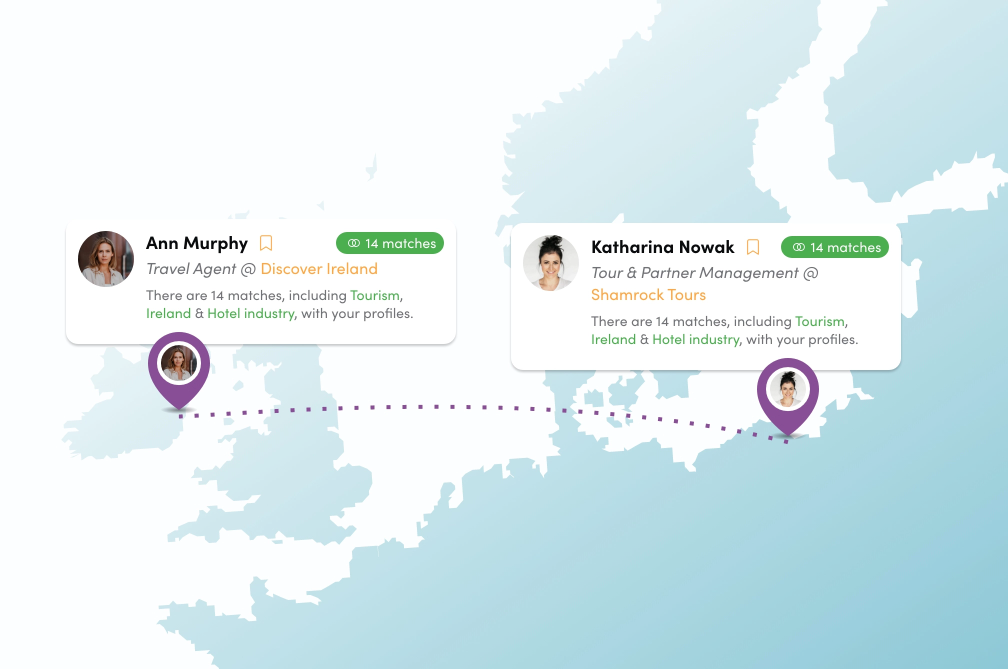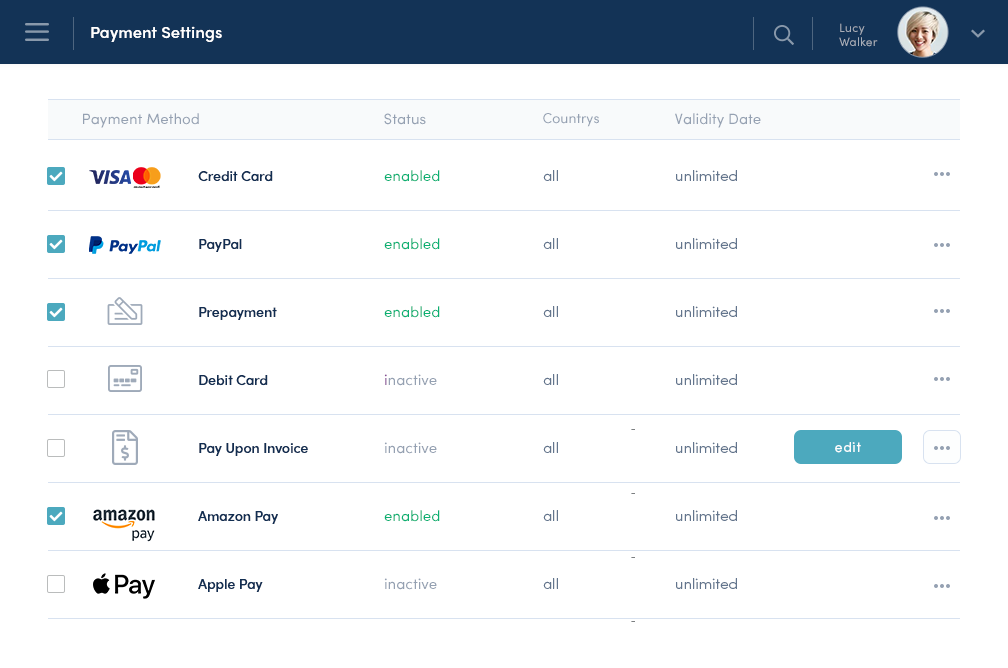In the ever-changing landscape of business events, effective matchmaking has become an essential component of event planning. As events continue to grow in scale and complexity, organizing an effective matchmaking strategy that connects attendees with the right people and content has never been more critical. In this article, we will explore the key components of successful event matchmaking strategies, our 18 best practices, and ways to measure the success of your matchmaking strategy.
52% of trade fair, conference, and B2B event organisers consider B2B matchmaking to be a crucial success factor for their event. This was revealed by a survey that we recently published in a Converve white paper. The publisher m+a Verlag reached a similar conclusion in the run-up to this year’s trade fair symposium in Frankfurt: 49% of participants see a need to expand matchmaking services.

This is Conny. Conny helps event professionals like you facilitate their event matchmaking strategies. In this article, you will learn how to develop your own matchmaking strategy. Why not hop on a demo with Conny afterward?
Of course, more and more B2B event participants expect a measurable return on investment for their attendance – this applies to exhibitors as well as sponsors and visitors. In this context, the focus lies on the kinds of new contacts an event participator manages to acquire.
However, it is often the case that event organisers only start thinking about matchmaking, particularly software-supported matchmaking, at the very end of the planning process. At this point, they attempt to put the cart before the horse – which often fails.
Converve has been providing business networking solutions for 22 years. We asked our project managers, software developers, and communication experts what they consider to be the most important success criteria for matchmaking, and the answers they gave are presented in the list below.
First, we will dive into what successful matchmaking is all about and how you can develop a matchmaking strategy for your event yourself. If you want to skip ahead to our 18 Sucess Factors, you can do so with a link in our summary to the right.
Understanding Event Matchmaking
What is Event Matchmaking?
Event matchmaking refers to the process of connecting attendees at an event with the right people and content. This ensures that attendees maximize their time spent at the event by connecting with relevant content, speakers, and other attendees. Event matchmaking helps to create a more personalized, engaging, and productive event experience for attendees.

At its core, event matchmaking is about creating connections. It’s about bringing people together in a way that is meaningful and valuable to them. Whether it’s connecting attendees with potential business partners, introducing them to new ideas and perspectives, or helping them find the perfect session to attend, event matchmaking is all about helping attendees make the most of their time at the event
The Importance of Effective Matchmaking in Events
Effective event matchmaking is essential to the success of the event. It creates a more engaging and productive event experience for attendees and ultimately leads to better outcomes for event hosts and sponsors. Effective matchmaking helps attendees to uncover new opportunities, drive collaboration, and build long-lasting relationships. Moreover, it can increase the perceived value of the event and improve attendee satisfaction rates.
One of the key benefits of effective event matchmaking is that it helps attendees to discover new ideas and perspectives. By connecting attendees with like-minded individuals and thought leaders in their industry, event matchmaking can help attendees to expand their horizons and gain new insights into their work. This can be particularly valuable for attendees who are looking to stay ahead of the curve in their field and want to be exposed to the latest trends and ideas.
Another key benefit of effective event matchmaking is that it can help attendees to build long-lasting relationships. By connecting attendees with potential business partners, collaborators, and mentors, event matchmaking can help attendees to build a strong network of contacts that they can rely on for years to come. This can be particularly valuable for attendees who are just starting out in their careers or who are looking to make a career change.
Finally, effective event matchmaking can help to increase the perceived value of the event. When attendees feel that they have been matched with the right people and content, they are more likely to view the event as a valuable investment of their time and resources. This can lead to higher attendee satisfaction rates and increased attendance at future events.
In conclusion, event matchmaking is an essential part of creating a successful event experience for attendees. By connecting attendees with the right people and content, event matchmaking can help to create a more engaging, productive, and valuable event experience for everyone involved.
Key Components of a Successful Matchmaking Strategy
Organizing an event can be a daunting task, but with a successful matchmaking strategy, you can ensure that your attendees have a memorable experience. A matchmaking strategy is a process that helps you connect your attendees with the right people, products, and services at your event. In this article, we will discuss the key components of a successful matchmaking strategy that will help you achieve your event’s goals and objectives.
Defining Your Event’s Goals and Objectives
The first step in developing a successful matchmaking strategy for your event is to define your goals and objectives. Your goals and objectives will shape the entire matchmaking experience and help you set metrics for measuring your strategy’s success. Before building your matchmaking strategy, you need to determine what your event is trying to achieve, what your target audience looks like, and what they hope to get out of the event.
For instance, if your event is a trade show, your goal may be to connect attendees with exhibitors to generate leads and sales. Alternatively, if your event is a conference, your objective may be to facilitate networking opportunities for attendees to learn from industry leaders and peers.
Identifying Your Target Audience
The next critical step in developing an effective matchmaking strategy is to identify your target audience. Who is your event designed for, and what types of attendees are most likely to attend? Knowing your target audience is crucial in building an effective matchmaking strategy, as it will help you tailor your matchmaking experience to their needs and interests.
For example, if your event is a technology conference, your target audience may include software developers, technology executives, and entrepreneurs. Understanding your target audience will help you create a matchmaking experience that is relevant and valuable to them.
Creating a Comprehensive Attendee Profile
Once you understand your target audience, the next step is to create a comprehensive attendee profile. Your attendee profile should capture key information about your attendees, including their interests, job title, industry, and professional background. This information will help you segment your attendees and create more personalized matchmaking experiences.
This is what a typical event matchmaking algorithm looks like. The more you segment keywords for your attendee profiles, the better recommendations our algorithm provides.
For instance, if you have a mix of senior-level executives and entry-level professionals attending your event, you may want to create different matchmaking experiences for each group. Senior-level executives may be interested in attending exclusive networking events, while entry-level professionals may prefer attending educational sessions to learn new skills.
In conclusion, a successful matchmaking strategy is an essential component of any event. By defining your event’s goals and objectives, identifying your target audience, and creating a comprehensive attendee profile, you can create a matchmaking experience that is tailored to your attendees’ needs and interests. With a successful matchmaking strategy, you can ensure that your attendees have a valuable and memorable experience at your event.
Measuring the Success of Your Matchmaking Strategy
Key Performance Indicators (KPIs) for Event Matchmaking
To measure the success of your matchmaking strategy, you need to establish key performance indicators (KPIs). KPIs are metrics that help you measure how well your matchmaking strategy is performing against predetermined goals and objectives. KPIs can include metrics such as the number of successful matches, the number of attendees who attended networking events, and the overall satisfaction rate of your attendees.
Find out how you can track your Event KPIs with our reporting app.
Gathering Attendee Feedback and Testimonials
Gathering feedback and testimonials from your attendees is a crucial step in measuring the effectiveness of your matchmaking strategy. Feedback and testimonials can help you understand what worked well and what can be improved, allowing you to make adjustments for future events. You can use feedback and testimonials to refine your matchmaking strategy and to attract more attendees to your future events.
Analyzing Data and Adjusting Your Strategy for Future Events
Finally, analyzing data and adjusting your strategy for future events is critical in unlocking the value of effective event matchmaking. Analyzing data and attendee feedback will help you spot areas for improvement, refine your strategy, and ultimately, create more successful events. Adjusting your strategy based on data-driven insights will help you unlock the full potential of event matchmaking and drive better outcomes for your attendees and event sponsors.
18 Success Factors for Event Matchmaking
We have been setting up matchmaking platforms for our customers for over 22 years. When we take a look at the best performing events, these are the success defining factors.
The right timing
Make it as easy as possible for participants to register. Lengthy registration forms will scare people off. Not only are B2B event visitors deciding to participate at increasingly later times, they are also starting to prepare for their visit closer and closer to the date of the event.
Based on our experience, we recommend activating software-based matchmaking 2-4 weeks before the event. By then, participants must also have optimised their profiles for matchmaking, e.g. by providing a link to their LinkedIn or XING profile. Start a countdown (e.g. “Only 12 days to go until you can arrange meetings”) to add a level of suspense.
Understand the decision-making and power structures on the market and arrange matchmaking accordingly
Which group of participants should be able to view which other group of participants and be able to request meetings? Should visitors be able to arrange meetings with one another via the platform? Should exhibitors be able to actively contact visitors to arrange a meeting, or should only the reverse apply? These conceptual questions depend on the espective market and must be taken into consideration when planning B2B matchmaking.
Effective use of payment and discount codes
Discount-, VIP- and early-bird schemes can boost registrations many weeks prior to the event. Matchmaking will only work once a relevant number of active participants use the platform in due time before the event.

Active registration for matchmaking
Participants must be able to consciously decide to participate in matchmaking. Data-protection regulations aside: you won’t succeed by simply entering all visitors into the tool, as this will result in too many “inactive” individuals on the platform, which will lead to frustration for “active” participants.
Gatekeepers as a quality guarantor
Similar to a bouncer at a club, the person(s) responsible for the matchmaking platform should examine all registrations and decide who is and who isn’t allowed to participate. This ensures a high quality of participants and prevents misuse or spam. For example, with the Converve platform, you can set up rights management in a granular way, e.g.: “Mr. Schmidt is responsible for all new registrations for the participant group ‘Buyers from Norway and Sweden’.”
Get participants involved and maintain contact
Personalized messages such as “Additional participants have registered who meet your search criteria” encourage matchmaking participants to log into their profile and actively use the platform. Another good practice is to announce suitable event formats – “Further workshops have been added that correspond with your interests”, for example.
Contact inactive participants
If registered participants have not yet arranged any meetings via the platform, send reminder emails to precisely this target group, in line with the motto “Event XY starts in 6 days – arrange your meetings now via the matchmaking platform”. The Converve platform allows you to address such groups of people in a targeted way.
Telephone marketing geared at exhibitors or visitors
We recommend the targeted use of telephone marketing campaigns, in order to inform exhibitors or VIP visitor target groups about the matchmaking service and to conduct a quick phone tutorial. This also allows you to find out whether the stored contacts (e.g. stand constructor or marketing decision-maker) are really the right people for arranging matchmaking meetings, or whether a different company employee might be better suited for this (e.g. a sales representative).
Placing messages from sponsors
Based on certain criteria (e.g. foreign address, job title), you can deduce special needs the participants may have and then place targeted sponsoring messages – e.g. offering a VIP shuttle from the airport, hotel offers, or ads for the International Visitors Lounge.
Initial kick-off email
When addressing (potential) participants of a matchmaking platform for the first time, don’t bombard them. Reaching out to participants in a targeted way – ideally with a personal touch – promises more success than a scattergun approach.
Short and simple registration forms
Keep the registration forms as short as possible and don’t ask for too much information in the first step. A straightforward registration process is crucial for the customer experience. Collect the information required for matchmaking at a later point or have it generated via a social login.
Don’t use too many different platforms
Large trade fairs in particular often experience the phenomenon of a multitude of platforms and providers being involved in the process. One platform to register participation, another for CRM, and a further platform for the event website, plus one for email marketing, the event app, reporting… This increases the level of complexity and makes the exchange of data between systems more difficult.
Avoid the need for different passwords
In relation to this, we should also mention the password issue. Make things as easy as possible for your participants and avoid the requirement of several different passwords for your services. Always consider the customer’s point of view!
Prefilled registrations
In an ideal case, the registration process for the event (ticketing) should be directly connected to the matchmaking service. If this isn’t possible, export the ticketing data and fill it into the matchmaking registration forms. This will make it easier for participants to register.
Less is more
In all your communication with the participants, consider how you can offer the best experience for your customers. What information do the participants really need? What can you leave out?
Communicate via the platform instead of just by email
The Converve platform also allows you to communicate with your participants. This means that all relevant information can always be found in one place and participants don’t need to spend ages searching for details. This makes participation much easier.

Use explanatory videos
Don’t presume that your participants know how everything works – instead, inform them about the advantages and the mechanisms of matchmaking. Here is an example of informative and emotional video communication:
Employ matchmaking managers
The first German trade fair organisation recently established the role of Matchmaking Manager (Reed Exhibitions Deutschland). This shows how important this issue is. Matchmaking is crucial for securing the future success of trade fairs and B2B events.
The Converve team has already supported 3,000 events in setting up and operating successful matchmaking platforms. Get in touch, so that we can discuss a suitable concept for your event!
Conclusion
Effective event matchmaking is critical in creating a productive and engaging event experience for attendees. It helps attendees uncover new opportunities, drive collaboration, and build long-lasting relationships. Building a successful matchmaking strategy requires defining your goals and objectives, identifying your target audience, creating comprehensive attendee profiles, implementing best practices such as using technology and encouraging engagement, and measuring your strategy’s success through data and attendee feedback. By following these key components and best practices, you can unlock the power of effective event matchmaking strategies for your next event.



